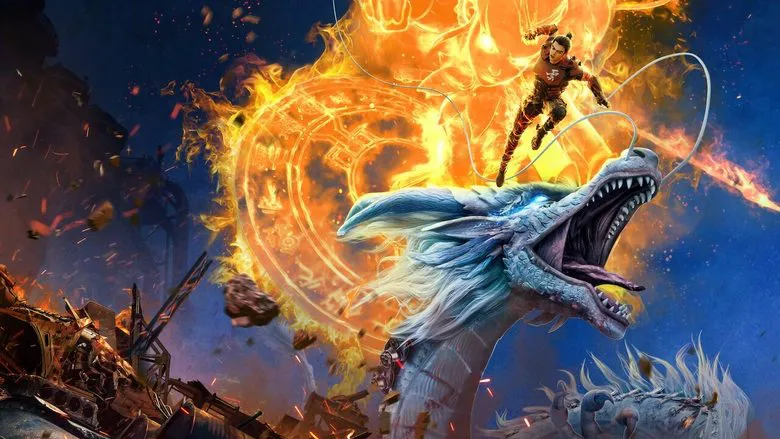As information technology rapidly advances and the fan economy flourishes, the adaptation of intellectual property (IP) into creative works has become a significant trend in the film and television industry. The classic IP of Nezha, with its large and stable audience base and substantial commercial value, is a perennial favorite among filmmakers. Adaptations centered around Nezha have historically resonated well with audiences.
From China’s pioneering color widescreen animated feature, “Nezha Conquers the Dragon King” (1979), to the memorable animated series “The Legend of Nezha” (2003), and the record-breaking animated film “Ne Zha” (2019), this iconic mythological figure consistently demonstrates boundless potential and enduring vitality.
“New Gods: Nezha Reborn” continues this creative tradition, offering a modern reimagining of the classic myth imbued with contemporary spirit and energy. The film unfolds three thousand years after the great battle of the Gods, a period of chaos where gods and humans faced a cataclysmic event. A fragment of Nezha’s soul survives, reincarnating across ages. In his latest incarnation, he merges with Li Yunxiang, a motorcycle enthusiast living in Donghai City. As the Dragon Clan plots to eliminate the reincarnated Nezha, a new divine arrangement looms, and war threatens to erupt.
The film daringly reimagines the well-known myth by integrating elements of metal, motorcycles, and steampunk aesthetics. This bold fusion creates a visually stimulating cinematic experience that cleverly melds cyberpunk elements with contemporary social realities. By offering a modern interpretation of the traditional myth’s core values, “Nezha Reborn” balances commercial appeal with intellectual depth, exploring the aesthetic and ideological impact of blending Western science fiction’s punk ethos with Eastern mythology. The focus is particularly sharp on the role of steampunk and cyberpunk in creating a fresh narrative and visual language.
Cyberpunk and Steampunk in “Nezha Reborn”
Cyberpunk and steampunk, while distinct, are interrelated subgenres within Western science fiction literature and film. They exist alongside other “punk” offshoots like dieselpunk, atompunk, and nanopunk each bringing its unique flavors
In recent times, cyberpunk has risen to prominence in film, architecture, and design. Fueled by the popularity of ventures such as “Cyberpunk 2077,” it has become a notable facet of pop culture. As such, cyberpunk blends an edgy aesthetic with profound thematic complexity. Put concisely it marries “high tech” with “low life.”
Cyberpunk narratives frequently portray oppressive futures in which advanced technologies, like cybernetic enhancements and androids, generate immense profits for corporations and governments. Wealthy elites occupy gleaming skyscrapers, indulging in extravagance, while the impoverished masses struggle in crowded, dimly lit slums. Cyberpunk narratives often explore themes such as artificial intelligence and genetic engineering, considering their societal, ethical, and technological ramifications.
Steampunk and cyberpunk may be viewed as contrasting twins, each branch growing significantly during the 1980s and 1990s in areas deeply intertwined with technology
Though their sentiments toward technology, however, are dramatically different: Cyberpunk embodies a fear and pessimism associated with technological progress while steampunk anticipates a brighter future driven by such advancements embodying utopian-inspired aspirations. “Steam” points back towards technological strength seen during the First Industrial Revolution while “punk” expresses themes central for expressing revolution & individuality thus leading one to interpret Steampunk accordingly: a sub cultural, avante garde concept and rebellious in spirit inside an alternate universe dependent on powered by steam.
Fusion of Sci-Fi Punk with in Eastern Mythology
“Nezha Reborn”, as the opening installment from Light Chaser Animation’s series entitled"New Gods," bears hallmarks unique with designs reminiscent taken directly origins such found inside Ming Dynasty’s “Invesiture Gods literature along referencing to older content; film ‘Nezha Conquer’ from (1979).”
Through this medium via reincarnation allows a introduction or Nezha, Ao Guang Dragon Third characters such including along additional players aiming or re-convey themes into what become myths coexist and humans too
Furthermore film blends Western/Sci visual blending era into Republican into visually amazing experience
Any animated flick calls also thought as requires themes alongside presentation
"NEZHA Reborn fuses in the world eastern element’s new way that in shaping design roles’s
Significance of Exploring Eastern Fusion
Breaking those limitations it aims connect ages with many